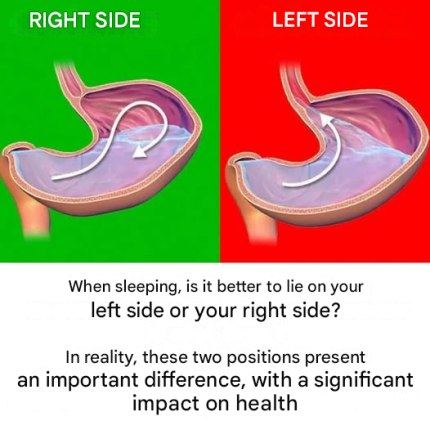Every night, people search for the most comfortable way to fall asleep on the back, stomach, or curled on one side. While comfort is important, your sleeping position also has a major impact on your overall health. The side you choose can affect your spine, digestion, breathing, and even heart health. Experts increasingly agree that one side offers the most benefits: the left side.
Why Sleeping on Your Back or Stomach Can Be Harmful
Many assume sleeping on the back promotes good posture. However, this position can place uneven pressure on the spine and hips. Without proper support under the lower back, pain often develops over time. Additionally, sleeping on the back may worsen snoring and sleep apnea because gravity causes the tongue to fall backward, narrowing airways. Sleeping on the stomach may feel relaxing at first, but it strains the neck and back. Since your head must turn to one side, the neck remains twisted for hours, leading to stiffness and potential nerve compression. It also compresses internal organs like the lungs and stomach, interfering with normal breathing and digestion.

Why the Left Side Is Often the Best
Sleeping on your left side is widely considered the healthiest position. It supports spinal alignment, encourages better breathing, and promotes smooth digestion. The stomach and pancreas hang naturally on the left side, allowing gravity to help food and digestive juices move more efficiently. This position also reduces acid reflux and heartburn, as it prevents stomach acid from flowing back into the esophagus. For people prone to nighttime indigestion or bloating, lying on the left side can bring noticeable relief.
A Boon for Heart and Circulation
The heart is located slightly to the left side of the body. Sleeping on that side can help blood flow more freely toward the heart, enhancing circulation. Pregnant women are often advised to rest on their left side because it improves blood flow to the fetus and reduces pressure on the liver. This position also eases swelling in the legs by helping lymphatic drainage.
Left or Right: What About the Other Side?
Sleeping on the right side can also have certain advantages, such as relieving pressure from specific organs. However, it may increase acid reflux in some people, as the stomach’s position makes it easier for acid to escape into the esophagus. For those with heart conditions, right-side sleeping may sometimes put more pressure on the heart and lungs, leading to mild discomfort or shortness of breath.

Finding Balance and Comfort
While science favors the left side, the most important rule is comfort. If staying on your left side causes shoulder or hip pain, try alternating sides during the night. Use supportive pillows between your knees or under your waist to maintain spinal alignment and reduce strain. For back sleepers, placing a small pillow under the knees can help keep the spine neutral.
Final Thoughts: Prioritize Quality Rest
Good sleep isn’t just about the number of hours — it’s about how well your body rests and recovers. Adopting the left-side sleeping position can improve breathing, digestion, and heart function while reducing back pain and reflux. However, comfort and consistency matter most. Find the posture that lets you wake up refreshed and pain-free.

















